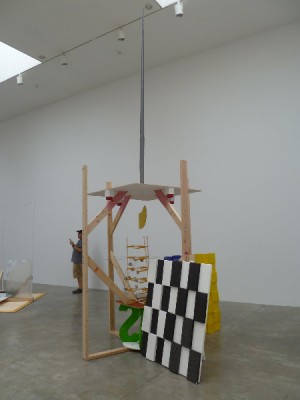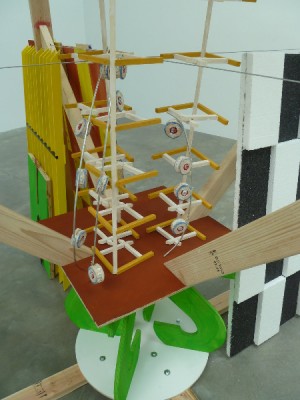
Silencing My Linear Self: Richard Tuttle on the Spiritual in Contemporary Art
Rational thought is overrated. Structured. Ordered. Sequential. Converging to find that one right answer. This was not the process shared by the artist Richard Tuttle during his Logan Lecture at the Denver Art Museum in March. Some would not define it as a lecture or a talk, but instead the ramblings of a non-linear thinker. Tuttle’s thoughts meandered and he struggled to find language to accurately describe his brilliant philosophical and aesthetic concepts. Well into his presentation he said: “the problem with language is to find the words in which we are sharing.”
I took copious notes causing me to focus on the words and phrases that he stammered about expressing, and because I was attuned to his words I was able to capture his final thoughts as they formed into something coherent, such as: “We don’t really know what art is. No one can finely define it.”
The focus of the Spring Logan Lecture Series at Denver Art Museum was on five artists, selected by Modern & Contemporary Curator Gwen Chanzit, whose primary concern was for materiality. The final artist in the series, Nick Cave, speaks on May 16 at 7 p.m. Tuttle famously said before this night: “I make form out of material, but I also make material out of form.”
In Denver, Tuttle spoke about his recent (May-July 2011) exhibition at the Pace Gallery in Chelsea, “What’s the Wind,” which featured seven large-scale sculptures by the artist who lives in New Mexico with his wife, the poet Mei-mei Berssenbrugge. He said: “I’d rather be a servant of art,” and added that while he loves materials, his art is not about materiality. “It’s about exploring the physical world and the dimensional world. I love materials but the dream would be to make something on the spiritual side of things rather than the material side of things.”
What a refreshingly honest admission. Not many contemporary artists would dare speak of things nonmaterial and fewer still who would go so far as to admit they would prefer to make work that is incorporeal.
“If one hopes to shape the world we live in, unless we have access to those [spiritual] ideas, then we cannot hope to do more than work on the surface of where things are now,” Tuttle said.
For Tuttle, sculpture must be satisfying from eight viewing points to provide 360 degrees of satisfaction. Describing his recent works as structured from frames and elements within frames with intentionally altered structures inviting the viewer inside to see the details and experience the dynamic inside of the work and then exterior points from which viewers are invited to stand back and take in the totality of the work. In Tuttle’s words, “the spaces inter-penetrate.” Some even extend metaphorically into the underworld via use of a long acute angle. For Tuttle, matter is then defined by penetrations of abstract space.
He went on to explain that the way the brain and eye work the artist has a lot of freedom.
“When the work comes to a point, at that point should be freedom and not slavery. Most of us would rather be told what to do rather than to face freedom. Why Tuttle makes art is to introduce freedom into the society. A perceived artwork that tells you what to think or how to act is not helpful to society,” Tuttle said.
For Tuttle, both the artist and the viewer are submissive to the art. “It’s a service to do the most with your life that you can do in the world. The job of the artist is to give people something to see not to give them something to look at. You have to know the difference between looking and seeing.”
During the question and answer period he took that one step deeper, explaining that the most important questions an artist can ask of him or her self are the ones that have not yet become thoughts or words. Looking into that one thought or question is scary and frightening which he described as a whiteness. “The same scariness in myself is black,” he added. “It’s this tremendous fear, but art is the best tool to conquer our fears.” Tuttle then went on to explain that in America we have a rivalry between a purely spiritual pursuit and an artistic pursuit. “I have work that is spiritual and what I do to fulfill the spiritual side [of me], and then there is the making side.”
Tuttle said he writes down when he should be making something and emphasized the importance of creative rest because the creating can be difficult and taxing. He then writes down the time for creating. But his process he admitted involves contacting his angel or guardian spirits and submitting to do whatever they want him to do.
“The truth is that art is taking care of me. I’m not in a position to take care of art.”






